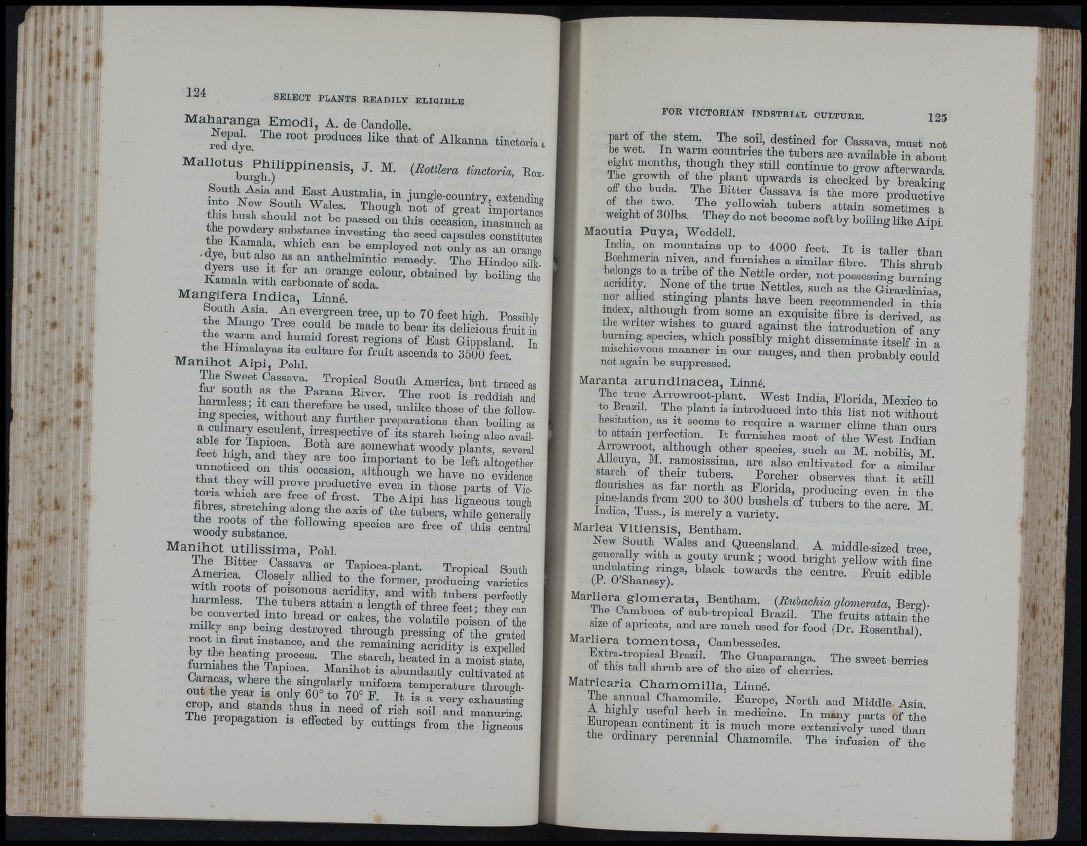
f • I'
124 SELECT PLANTS READILY ELIGIBLE
Maharanga Emodi, A. de Candolle.
S / e . tm o taù a
» - l u e s
ii: » s r ^ dvP W 1 1 omplojed not only as an oraiwe
d S 1 s ? iî fo “ The Hindoo sültXMM
-U k “ °™®® obtained Kamala with carbonate of soda. by boiling tie
Mangifera Indica, Linné.
^^ovsveen tree, np to 70 feet high. Possibh
the Mango Tree could be made to bear its delicious fruit in
the m T l regions of East Gippsland. In
e Himalayas its culture for fruit ascends to 3500 feet
M a n ih o t A lp i, Pohl.
The Sweet Cassawa Tropical South America, bnt traced as
far south as the Parana Elver. The root is r e d d i r l d
harmless; it csm therefore be used, unlike those of the folio*.
O species, without any further preparations than bollili» as
? b l1Z U ® M ® "‘ > ™ 'f T®°*'™ h<iing also availfeel
i° 1, ,1® 1. '^’'® ®«“ ewhat woody plants, several
1 M “ -® .‘ 00 in ro rta n t to b? fe ft al’t i j l t
ttat th 1 ?M 1 i occasion, although we have no evfdenca
toat they WÜ1 prove productive even in those parts of Viv
Z Z Z Z U T Tigneous tougi
t t ? ?o?te o t i f I t U of the tubers, while generally
Manihot utilissima, Pohl.
AAml eeiircfao lMClolsleTly Uallri e°dJ rtotT t®he® f‘^oTrm'®e“r*,- prodtruocpiniec-a lv arSieotuieths
h l m k l of poisonous acridity, and with tubera perfectly
¿armless. The tubers attain a length of three feet; they can
l i l k T rsaapi® b?e ing Udestrrot y e°ad ®t'h‘‘r'®o®u’ g“h* ®p r™es's-‘i*n"g® opfo itshoen oorfa ttehde
b ^ th e if j remaining acridity is expelled
by the heating process. The starch, heated in a moist state
fornishes the Tapioca. Manihot is abundantly cultivated at
Caracas, where the singularly uniform t em p e r a tu r f r ^ w L
out the year is only 60° to 70° E. I t is a very exhausthig
crop, and stands thus in need of rich soil and manurincr
The piopagation is effected by cuttings from the ligneous
FOR VICTORIAN INDSTRIAL CULTURE. 125
part of the stem. The soil, destined for Cassava, must not
i r countries the tubers are available in about
eight months, though they still continue to grow afterwards
The growth of the plant upwards is checked by breaking
off the buds. The Bitter Cassava is the more productive
• i f iln iV ml tubers attain sometimes a
weight of 3 Olbs. They do not become soft by boiling like Aipi.
Maoutia Puya, Weddell.
Lidia, on mountains up to 4000 feet. I t is taller than
Boehmeria nivea, and furnishes a similar fibre. This shrub
belongs to a tribe of the Nettle order, not possessing burning
acridity. None of the true Nettles, such as the GLardinias
nor allied stinging plants have been recommended in this
index, although from some an exquisite fibre is derived as
the writer wishes to guard against the introduction of Lny
burning species, wbicb possibly might disseminate itself in a
mischievous manner in our ranges, and then probably could
not again be suppressed.
Maranta arundinacea, Linné.
to Brazil. The plant i.s mtrodiiced into this list not without
hesitatmn, as it seems to require a warmer clime than ours
to attain perfection. I t furnishes most of the West Indian
Arrowroot although other species, such as M. nobilis M
Allouya, M. ramosissima, are also cultivated for a similar
starch of them tubers. Porcher observes that it still
flourishes as far north as Florida, producing even in the
pme-lands from 200 to 300 bushels of tubers to the acre M
indica, Tuss., is merely a variety.
Marlea V itie n s is , Bentham.
New South Wales and Queensland. A middle-sized tree
generally with a gouty trunk ; wood bright yellow with fin^
(B O’Shanesy)"^^’ towards the centre. Fruit edible
Marliera glomerata, Bentham. {Pubachia glomerata, Berg)-
The Camhuca of sub-tropical Brazil. The fruits attain the
size ot apricots, and are much used for food (Dr. Bosenthal).
Marliera tomentosa, Cambessedes.
Extra-tropical Brazil. The Guaparanga. The sweet berries
of this tall shrub are of the size of cherries.
Matricaria Chamomilla, Linné.
The an^nual Chanaomile. Europe, North and Middle Asia.
ighly useful herb in medicine. In many parts of the
European continent it is much more extensively used than
the ordinary perennial Chamomile. The infusion of the
9 I¡!1' / '.til
'f
i '
I